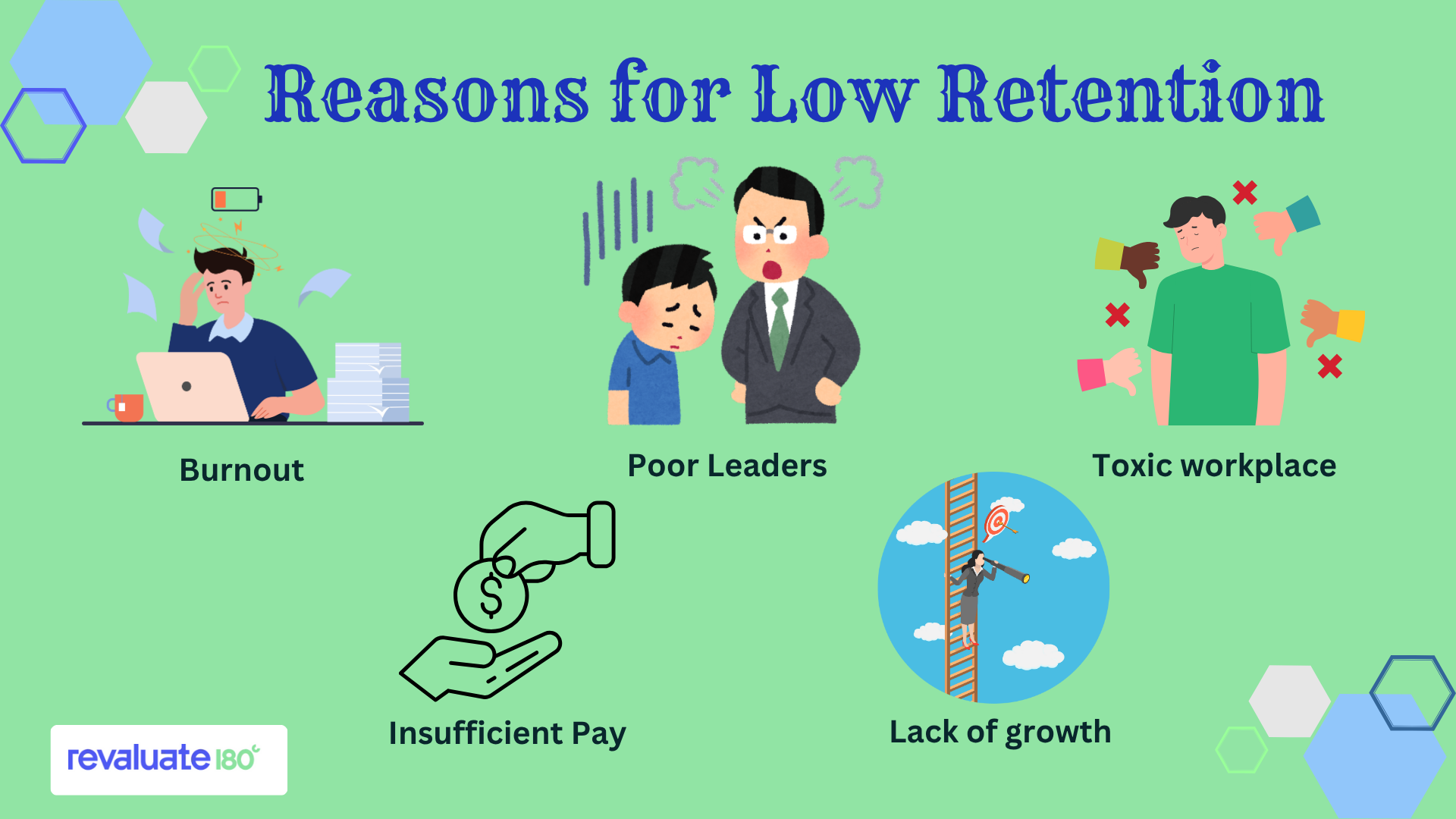Employee recruitment does not stop with hiring the right employees for the right job roles. The right hires become profitable for the company only if they stay and contribute to the company's growth over a long period.
Exiting employees can cost companies between 50% and 200% of the employee's annual salary, in addition to the time and resources spent on hiring.
Therefore, companies must implement effective retention initiatives to keep their employees engaged and productive, ensuring they do not consider leaving the company. In this post, we’ll learn about employee retention and why it is an important aspect of a company's growth.
TL;DR
- Failing to address employees’ needs and concerns can lead to sudden turnovers, which can have a significant impact on a company in many ways.
- Companies must ensure that they retain their top talent and value their contributions.
- Eliminating the root causes of turnover by providing a great work culture, proper feedback channels, and prioritizing employee wellness and engagement can help improve employee retention rates.
- You can leverage the help of data-driven insights from platforms like Revaluate180 to refine your retention initiatives.
What is Employee Retention?
Employee retention refers to a company's ability to keep its employees engaged, growing professionally and personally, and committed to contributing to the organization's success.
Employee retention initiatives help companies avoid sudden, sharp employee exits, also termed turnover. Calculating the turnover rate over a given period determines how well a company performs in retaining its employees.
Employee Retention Explained
Companies hire and train recruits with the hope that they will work for them and contribute to their long-term growth. Sudden spikes in employee turnover rates indicate that a company is struggling to retain its employees. Consequently, the company must initiate another round of hiring drives to fill critical job roles, ensuring the business is not affected. If such hiring drives occur frequently within a financial year, they can result in long-term losses.
On the other hand, companies that value their employees and provide them with meaningful job roles, while meeting their basic needs and demands, tend to have higher retention rates. Similarly, employees seek opportunities elsewhere when their company fails to meet their expectations, such as flexible work hours, timely recognition, career advancement, and other benefits.
Why Employee Retention is Important?
Before we understand how employee retention impacts a company’s progress, let us see some employee retention statistics that highlight key factors for retention:
- An insight from Work Institute shows that over 40% employees left the company within 90 days of joining. The reasons cited were poor work-life balance, limited growth opportunities, and mismatches between job descriptions and job roles.
- An insight from Tiny Pulse suggests that employees are three times more likely to seek alternative job opportunities if their team and leaders do not support them.
- The Bureau of Labor Statistics shows that men had longer retention rates in the workforce than women. This diversity in retention rates highlights the need to implement more supportive policies to create an inclusive workplace that supports all genders.
As mentioned in the beginning, replacing an employee costs around 1.5 to 2 times the salary of the leaving employee. This includes the costs of recruiting, onboarding, and training, as well as providing an attractive pay package to the recruit.
If this process repeats for several job roles in a consistent manner, the company's losses will continue to compound. Here are some of the noticeable impact points of low employee retention rates:
1. Company culture
A workplace thrives on the collective energy exhibited by its employees, especially the engagement level that they maintain with the company and their peers. Highly disengaged employees are often the ones who leave the company without any measurable traces. Such employees can also influence those around them, prompting more employees to behave similarly and fostering collective resentment towards the company.
2. Productivity and morale
When employees see most of their peers, seniors, and juniors leave the company back-to-back, it makes them anxious about their future in the company or even in their industry. This worry prevents them from being their productive best and consequently shows in the work they do. Furthermore, being in an environment surrounded by employees who frequently enter and exit lowers their morale.
3. Employer brand reputation
A company that holds frequent hiring drives for the same job roles or team positions is a clear red flag, indicating that previous employees could not sustain themselves there for long. Poor retention rates can negatively impact a company’s brand reputation as a trustworthy employer. New talent stops applying to such companies, anticipating a bad work environment.
4. Revenue and growth
The repetitive costs of hiring, onboarding, and training employees, only for them to exit within a year, result in significant losses for a company. Employees may not be able to make significant contributions at work unless they work together with their teams and leaders for a considerable period. Frequent hiring costs with no profitable business growth is the ultimate loss for a company.
What Causes Low Employee Retention
Employee turnover is definitely not desirable. However, the good part is that you can easily avoid turnover and the associated losses. All you need to do is find the root cause of why it is challenging to retain your employees.

Here are some of the common reasons why employee retention can be difficult in a company:
1. Poor management or leadership disconnect
Inability to meet the needs and demands of employees, inadequate communication channels between employees and management, and poor managerial decisions are often the primary reasons employees leave a company.
2. Lack of growth or learning opportunities
Career stagnation or periods of minimal work can often leave employees feeling anxious about their future within the company. Seeing their peers outside the company with better skills and faster career growth can prompt employees to consider similar opportunities.
3. Burnout and workload imbalance
Some teams have members who take on most of the workload. Their absence often causes chaos in the team, necessitating their presence at all times. This continuous work pressure and the team members' inability to share the workload often prompt critical resources to quit their jobs due to burnout.
4. Toxic work culture or lack of belonging
Hiring employees based on their backgrounds, providing special favors to one group of employees, failing to adhere to DEI hiring principles, and not valuing employees and their personal time often create a toxic work environment where employees do not feel like themselves.
5. Ineffective onboarding or hiring mismatches
Most employee turnovers happen because employees feel a misfit for the role that they applied for. What was mentioned in the job description is in no way relevant to the work assigned to the employees, which makes them quickly switch to another job so that they do not waste their precious time and knowledge.
6. Inadequate pay or recognition
Failing to provide timely recognition and rewarding employees in a way that they expect often leads to dissatisfaction. So, they start looking for opportunities where employers recognize and value employees for all significant contributions.
10 Benefits of Employee Retention
Focusing on retention initiatives helps companies with the following benefits:
1. Reduced Hiring and Onboarding Costs
Consider a mid-level employee with $60,000 annual salary. Hiring a new employee would cost around $20,000, with an additional $20,000 in onboarding costs. Additionally, the new employee may be hired for a higher package of $75,000 if the job role is critical and needs an immediate recruit.
Altogether, the cost goes almost double the previous employee’s salary. Efforts to retain the existing employee, by finding their concerns and addressing them, would have cost less than 10% of the employee’s annual salary.
2. Increased Productivity and Consistency
A team learns and evolves together by learning from past mistakes, embracing diversity, and collective strengths. Such learnings help teams progress consistently with a good rapport among their employees.
However, frequent entries and exits of employees in teams would mean they would have to spend considerable time training new joiners, rebuilding relationships, providing technical support, and more. Turnover and related actions often come up as setbacks that reduce overall productivity across the company.
3. Better Employee Morale and Engagement
Companies that strive to retain employees develop engagement initiatives that benefit all their employees. Such actions help employees feel valued and know that the company respects them for their work.
Post the COVID-19 pandemic, more employees are showing a preference towards workplaces that provide flexible work schedules over a hefty paycheque. Companies that meet such realistic employee demands see fewer turnovers while retaining their best employees.
4. Stronger Organizational Culture
The quality of a company’s services and deliverables is directly linked to the quality of its employees and its organizational culture. Companies with consistent employee turnover tend to be lower than their competitors, who retain their high-performing employees.

Retaining employees over the long term demonstrates that the company prioritizes a smooth work-life balance, fosters career growth, and provides learning opportunities for its employees. Embracing cultural diversity and fostering collective strengths helps establish a strong workplace culture.
5. Improved Customer Satisfaction
A company that sees frequent turnovers and replacements often finds its quality of service parameters compromised. This happens due to the time wasted on handovers, knowledge transfers, and differences in working styles. Naturally, such factors affect customer satisfaction as they cannot accept deteriorating quality for the investment they make.
Clients and customers see the satisfaction levels of employees in a company before deciding to do business with them. Happy and satisfied employees exhibit great enthusiasm when working, creating innovative and groundbreaking solutions that directly address consumer problems.
6. Knowledge Retention and Skill Continuity
Frequent turnovers would mean a company must spend sufficient resources to onboard and train recruits. In addition to company-level onboarding resources, new team members must spend considerable time to ensure a smooth transition to their new roles.
Also, it can take sufficient time for employees to gain experience in their field of work and develop a strong skillset required to exceed expectations. Ensuring long-term retention helps to ensure this skill continuity and shows consistent outputs and profits.
7. Better Innovation and Collaboration
When companies reduce their hiring frequency and focus on quality long-term hiring, they can allocate sufficient time to innovations and collaborations, resulting in higher business returns.
Retention ensures that employees gain sufficient knowledge about how things function within the company and how they can develop innovative ideas and creative solutions into actionable deliverables.
8. Stronger Employer Brand and Reputation
Any news on layoffs and turnovers relating to a company always brings its brand value into the limelight. Such news often prompts talented professionals in the market to reconsider their decision to apply to that company for any future role.
Similarly, poor retention and increased turnover often create the impression that the employer does not value their employees, promoting a toxic workplace culture where employees can be replaced as needed. Employee retention is therefore crucial to maintain a brand’s reputation.
9. Higher Revenue and Profitability
Where employees feel content and satisfied, they often find no reason to leave their jobs. They channel all their energy to continually exceed themselves, which is reflected in their professional growth and high-quality work.
Any company highly desires such characteristics, as their main aim is to ensure their employees stay content and give their best efforts at work. As a consequence, their profits increase, yielding their expected revenue.
10. Improved DEI and Psychological Safety Outcomes
Companies must value employees for their skill sets and work proficiency. Fostering unconscious biases while hiring, making unfair policies for specific genders and ethnicities, can make employees feel they are undervalued.
Retention happens when employees feel safe and comfortable in their work environment. Companies that implement measures to safeguard the interests of all employees, regardless of type, tend to have higher retention rates.
How to Calculate Employee Retention Rate
To calculate the retention rate during a given period, one must know the number of employees enrolled with the company from the start date to the end date of the period. Additionally, it is necessary to know the exact number of employees hired during this period.
With these parameters, the employee retention rate formula gives the retention rate of employees in a company.
Example:
Suppose a company has 500 employees at the beginning of a financial year and has 450 employees at the end of the year. During the year, around 25 employees were hired.
The retention rate is calculated as follows,
Retention rate = (450-25)/500 = 0.85 * 100 = 85%
Therefore, the company's retention rate for that year was 85%.
Retention rate and its significance:
There is no magic value for the retention rate, as this value can vary depending on the industry, its market scenario, and the size of its workforce. Generally, a retention rate of 90% or above is considered an excellent score, where companies strive to satisfy their employees by providing them with adequate raises and benefits.
Best Strategies to Improve Employee Retention
It is now clear that employee retention is an unavoidable factor that companies must ensure to prevent turnover losses. Just as you can avoid bad hires, you can also use these methods to retain employees who do not wish to leave your company.
1. Hire for culture-fit and long-term potential
Ensure that the candidates you hire are a good fit for your job role and your company’s work culture, so they do not encounter any discrepancies in the actual work they perform.
2. Strengthen onboarding and mentorship
Onboarding feedback surveys and one-on-one mentors can help identify any confusion that may prompt employees to consider switching jobs shortly after joining.
3. Offer growth and learning opportunities
Understand how employees wish to upskill themselves. Offer opportunities for learning and development in your company or by collaborating with e-learning portals.
4. Create a transparent feedback culture
Conduct regular engagement surveys to gauge the level of happiness and satisfaction among your employees. Such surveys help provide crucial insights that can prevent possible turnover spikes.
5. Recognize and reward consistently
Timely recognition and rewards, such as cash, coupons, vouchers, or any other mode preferred by employees, can be a motivator to encourage employees to perform better.
6. Prioritize employee well-being and work-life balance
Enforce the importance of quality work over hours spent on work right from the beginning of an employee’s onboarding. Implement sufficient mental health initiatives to monitor burnout levels and ensure a healthy work-life balance for employees.
7. Build great managers, not just teams
Train your managers to value their team members for their strengths and identify their distinct individual traits that can be leveraged for their benefit. Managers must not only pass orders, but also work alongside their team and lead them to perform better.
8. Use data and analytics to monitor engagement trends
Insights from various feedback surveys provide accurate data to reveal employee concerns and their potential impact on the company’s future. Leverage such analytics to develop efficient initiatives that retain your employees.
How Revaluate180 Helps You Improve Employee Retention
Employee retention measures are proactive steps that companies must take to prevent sudden, unexpected turnovers that can cause huge losses. Retention involves periodically monitoring employee satisfaction or engagement levels to understand causes of concern and unrest.
Employee engagement and feedback surveys are among the most effective tools for measuring your team’s pulse. These surveys generate valuable data that, when analyzed correctly, can guide effective retention and engagement initiatives. This is where Revaluate180 comes in, using AI and analytics to identify early signs of disengagement.
R180’s data-driven approach transforms employee feedback into actionable insights, enabling leaders to make informed decisions backed by data.
Our workshops and team-building activities foster a positive work culture, enabling team members to embrace unity in diversity and grow both personally and professionally.
Final Thoughts - Retention as a Business Advantage

Employee retention is no longer an option, but a mandatory factor that all companies must prioritize in today’s volatile business environment. Retention not only ensures the smooth functioning of day-to-day activities but also saves a company massive hiring and onboarding costs.
We saw how retention can stop companies from conducting frequent hiring drives. Retention initiatives help proactively monitor employee satisfaction levels, allowing any concerns to be smoothly resolved before employees consider leaving the company.
Out of the several retention and engagement initiatives, it can be overwhelming for company leaders and management professionals to decide what measures will work best for their employees. Feel free to reach out to us if you wish to assess your current retention scores and turn data into clear, actionable insights.

Unlock AI-Powered Hiring Analytics
Transform the way you hire with insights that create aligned, collaborative, and high-performing teams.
 Smarter Hiring Decisions
Smarter Hiring Decisions
 Reduce Expensive Turnover
Reduce Expensive Turnover
 AI-Driven Insights
AI-Driven Insights
 Optimize Team Performance
Optimize Team Performance

FAQs
1. What is the meaning of employee retention?
Employee retention refers to how companies keep their employees with them for an extended period after hiring them. Employees tend to remain with companies when they are satisfied with their work environment and the benefits provided by the company.
2. Is employee retention a good thing?
Yes, it is. Retention is beneficial for both companies and employees, as it tends to foster growth and productivity while they coexist.
3. Why is staff retention important for organizations?
Retention is a necessity for organizations that wish to achieve the following:
- A healthy and positive work culture
- High productivity among employees
- Building a strong employer brand
- Growth in terms of revenue and brand value
4. What are the 3Rs of employee retention?
- Respect: Creating a safe work environment where employees feel satisfied and are looked after in their overall wellness.
- Recognition: Valuing employees for all their contributions at work.
- Reward: Providing appropriate compensation and benefits for employees to boost their morale and make them exceed expectations.
5. What is an example of employee retention?
Keeping employees engaged at the workplace and improving their satisfaction with their current work environment is a great example of effective employee retention. Such measures ensure that employees do not think of leaving the company.
6. How can you improve employee retention?
- Hire for culture fit and long-term potential
- Strengthen onboarding and mentorship initiatives
- Offer opportunities for personal development and upskilling
- Create a transparent feedback culture
- Have a robust rewards and recognition culture
- Prioritize employee well-being and avoid burnout situations
- Build great managers, not just teams
- Use data and analytics to monitor engagement trends
7. How do you calculate employee retention rate?
By knowing the employees at the start and end of a given period, as well as the new hires during that period, you can calculate the retention rate for that period as follows.
